Morgan Campbell
Introduction
Since the economic liberalization of India in 1991, Chennai, India’s fourth largest city, has sought global city status in order to bring foreign investment into the city’s tertiary sector. Similar to Bangalore, Hyderabad, and Pune, Chennai has in recent years successfully branded itself as a major international IT destination. To compliment the city’s global image, officials have encouraged private developers to invest in and construct new and exciting public places of leisure and consumption, one of which is Café Coffee Day.
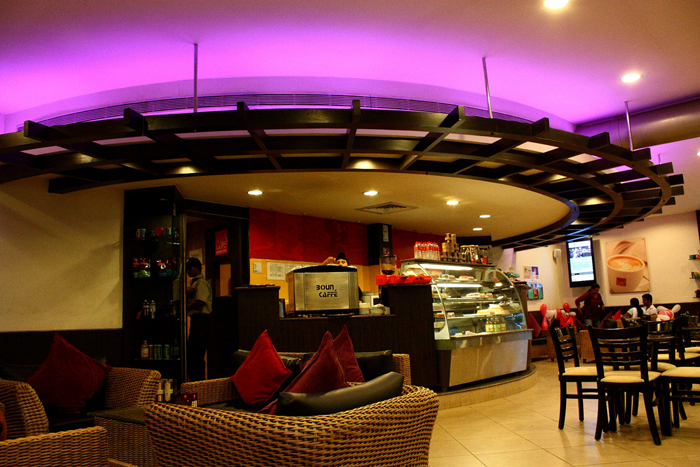
Siddhartha Lammata, Café Coffee Day Interior, Digital photo, 2010, Reproduced under Creative Commons.
1. Café Coffee Day, Chennai
‘There’s an inviting aroma in the air, and it’s intoxicating!’ [1]
It’s Valentine’s Day and we’re sitting at the Café Coffee Day in the Chennai’s Isphani Shopping Centre. This upscale coffee shop first opened in Bangalore in 1996, five years after India’s economic liberalization. Today Café Coffee Day has locations throughout Egypt, the Middle East, and Southeast Asia.
On 14 February, Indian couples of various ages and relationship stages are here to celebrate this increasingly global holiday by consuming chocolate cakes and caffeinated beverages with towering domes of whip cream. Teenagers lean into one another and share a single pair of white headphones; an iPod wedged comfortably between them. Attention however, is focused less on the human valentine and more on the amorous commodities dispersed throughout the café: mobile phones, TVs with Bollywood music videos on display, laptop computers, Facebook pages, and complimentary Cosmopolitan magazines—India edition—strategically angled on every café table. Older couples hold each other’s hands and turn the pages of the elaborate menu, a colorful display of items like Cold Sparkle Frappe, Mochachillo, and Sizzle Dazzle Brownie.
‘A lot can happen over coffee!’ is written out below each Café Coffee Day logo. However, on this February afternoon there is no activity, no lively conversation, and certainly none of the passion one associates with the café culture of Francois Truffaut, Jean-Luc Godard, or Valentine’s Day for that matter. The very fact that not a lot seems to be happening over coffee intensifies the awkwardness of this Hallmark Holiday and the mission of Café Coffee Day.
In the far corner of the café sit two Westerners. Or are they meditating? Their languid positions suggest that both are deliberately resisting the fact that a lot can happen over coffee. The guy, with his overgrown haircut and rugged tan sits up straight in the sleek, angular chair. Eyes closed, he is in the lotus position. Meanwhile, the girl with sun kissed highlights and a halter-top exposing her full back tattoo (a butterfly) dangles her legs over the side of the chair and slowly turns the pages of Lonely Planet South India. Perhaps sharing a Kaapi Nirvana, or what the café describes as a ‘chilled out espresso with subtle Caribbean flavors’ brought on this state of relaxation?
Although we are in India, the rope sandals, ali baba pants, and decorative leather jewelry of these travelers feel completely out of place in this clean and sophisticated atmosphere. But then, the Indian men who, despite the humidity, wear stonewashed jeans, button down shirts, and lightweight sweaters will look equally out of place as soon as they leave this middle class establishment.
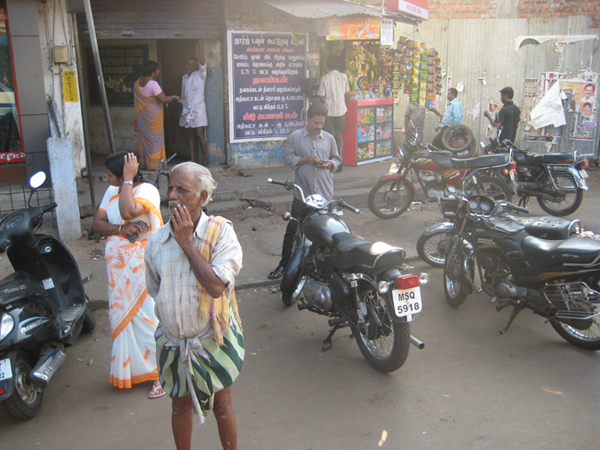
Morgan Campbell, Streetscape Outside Isphani Shopping Center, Digital photo, 2010, Reproduced with permission of the artist.
I change my mind. A lot can happen over coffee. Amidst the Cold Sparkles and Kaapi Nirvanas, cultural identity is being consumed in new and old ways.
Café Coffee Day is a place where those with disposable incomes and the right technology come to participate in the constructing of a new national identity that is far removed from the chaos, poverty, and pollution outside of this shopping center.
The menu invites us to ‘unplug from the world’, is that referencing the world that classifies India as a Least Developed Country? By unplugging from that world are we inevitably plugging into the world of neoliberal capitalism, or what economists and politicians like to call the “new” India?
The two foreign travellers stand up, stretch, and grab their large rucksacks. Like the circles of a tree trunk, the wear and tear of their luggage suggests a long elapse of time; a reminder that for many, visiting India represents a symbolic unplugging of that very world Café Coffee Day strives for. Although these travellers probably enjoyed their ‘handcrafted’ espresso beverage, they have no desire to linger in the atmosphere of Web 4.0. Chennai is not a popular backpacker destination. These two are most likely waiting for a train that will take them further south, to Pondicherry, Mylapore, or somewhere where ashrams are more numerous than call centers.
2. Class-as-lifestyle
Culture is fluid but culture-as-capital is static, easily fetishized, and easily mimicked. In his essay, “Macaulay’s (Cyber) Children: The Cultural Politics of Outsourcing India,” Shehzad Nadeem argues that cultural mimicry is ‘a way of solidifying one’s social status and identity, [and] has been given a new twist by economic globalization.’ [2]
Looking around Café Coffee Day it is easy to see ways in which culture is consumed and fetishized. In the process of fetishizing what is perceived of as cultural difference, a certain slipping of representation occurs. The aesthetic cultural differences between the Western travelers and locals are actively imagined and constructed. For example, most Indian women wear churidar or salwar trousers. If you ask a shopkeeper for the ali baba style, they know what you are referring to. Whether or not they sell them depends entirely on tourism. While the ali baba, or, what is more commonly known of as the harem pant, is not part of traditional Indian dress, it is part of the unspoken uniform of backpackers wishing to ‘integrate’ into the Eastern landscape. In contrast, one popular trend for Indian women is “The Rachel,” a haircut made popular in the 1990s sitcom Friends. Although the haircut is now outmoded in America, the image of Jennifer Aniston and her long, layered hair is found throughout upscale malls in Chennai and Bangalore.
That intoxicating aroma of Café Coffee Day is the magic of culture as a commodity that can transform from a vaporous fantasy into a physical place or purchasable object. It is pervasive, yet obtainable only for some. Not everyone in Chennai can afford Café Coffee Day’s luxury coffee beverage, but most anyone can tell you how to get to the structural fortress known as Isphani Shopping Centre.
3. Constructing Cultural Capital, Past/Present
But to assume that cultural commodification is a product of new India is to overlook the past. The first postcolonial debates about imperialism, dominant ideologies of power, and otherness originated from discussions revolving around culture. Orientalism was the term Edward Said [3] used to describe the way in which European ideology operated explicitly through political and economic power and implicitly through cultural mediums such as literature and the visual arts.
It was the fluid nature of culture and its ability to both aid and subvert dominant hegemonies that gave rise to the idea of difference, or a ‘proximity [of] relations that are conceived and perceived and inserted in a twofold space-time order: near and distant.’ [4] The result is, according to Homi Bhabha, that ‘The subject is graspable only in the passage between telling/told, between “here” and “somewhere else,” and in this double scene the very condition of cultural knowledge is the alienation of the subject.’ [5] Both Said and Bhabha are both pointing to culture’s subtle ability to ‘control, manipulate…what is a manifestly different in the world.’ [6]
Difference in imperial Chennai (then known as Madras) was reiterated in the physical landscape. The city’s maidan was a device of spatial distance. This large, open space separated the British who lived in the northern area of Fort St. George, away from the Indians who lived further south in George Town, thus reinforcing the notion of both proximity and distance. Similar to Isphani Shopping Centre, everyone knew and could recognize the space of the ‘other,’ but very few could access that other. For the majority of people, that other space was accessed through the imagination and became easily exoticized and fetishized.
4. World’s Fairs: The Global Exchange of Cultural Capital
‘World exhibitions propagate the universe of commodities.’ [7]
Utopian in aim, the early World’s Fairs were the first large-scale opportunity for Westerners to experience global culture. Open to the general public, the Fairs brought together capitalism and culture in the form of art, industry, manufacturing, and technology, capturing the imaginations of Western Europe. Before travel became ‘a serious enterprise, Europeans abroad merely projected their dreams, their arrogance, and rational thought onto other peoples of the world.’ [8] The nineteenth-century World’s Fair thus became an opportunity to reaffirm national boundaries while simultaneously building up dreams and fantasies of far away places. This was done largely though universal participation in the spectacle of the Fairs. Each nation was put on display, encouraging what Marx called the ‘fetishism of the world of commodities’ [9] so that what was produced was ‘A cultural discourse in which what is circulated is not “truth” but “representation.”’ [10]
Representations of the Orient came to the West in the form of cultural wares such as vases, shawls, tapestries and food items like tea and spices. Although many of these items had a use value, they were removed from their original context and their meaning became subject to alteration.
Although most Europeans never saw Indians, they were able to construct an image of India and Indian people through material objects. But could the same be said of Indians? Unique to imperial India was a political structure created by the British in which taxes were collected through an intricate system of hierarchies that relied entirely on the local population. As a result, even throughout the Raj, most Indians never saw an English person. [11] Creating an Indian population ‘who were not-quite-not-white and acted as buffers between the foreign rulers and the native ruled’ [12] is for Spivak one of the most concrete examples of the constructed colonial subject. While the decolonization of the 1950s and 60s signaled an end to many of these invisible transactions, a combination of new technologies and political ideologies offered innovative opportunities for cultural transactions.
Around the same time Franz Fanon’s A Dying Colonialism was being translated [13], The Beatles were staying at the Rishikesh Ashram, cultivating a new musical sound that would not only inspire an entire generation of vegetarian hippies, but would make the Indian ashram a popular, highly profitable tourist destination.
By the mid twentieth century travel became even easier. Instead of imagining the harem tent or putting the oriental vase on a shelf, international travel allowed almost complete access to the once mythical space of cultural other (provided one had the socio-economic means). Although post colonialism, civil rights, and multiculturalism challenged the reproduction of the exotic other, opportunities for global travel illustrated that there was, and there remains a healthy economy for this type of exchange.
5. Om Shanti: Selling the Exotic in Goa
Located approximately 1,000 Km west of Chennai, the café culture in the Indian state of Goa is world’s away from Café Coffee Day in Chennai. Although most cafés charge even more than $3 for a cappuccino, the interior space of these places promotes a completely different lifestyle choice. One that requires the same middle class income; but allows individuals to unplug from the 24-hour work culture and cultivate the spiritual inner self.
Since the mid to late 1990s, Goa has become the preferred tourist destination of both young and middle-aged westerners actively seeking alternative culture. Goa is infamous for its all night drum circles, daytime trance parties, and ayurvedic healing. It is where men go and exchange their briefcase for patchwork cloth satchels and women stop wearing bras.
Here at the Om Shanti café in Arambol there are no posh countertops, angular ceiling lights, or sleek couches. Café Coffee Day’s atmosphere of professionalism has been replaced with oversized cushions, draping fabrics, and candle lighting. Om Shanti, which essentially means past, present, and future peace, is where one goes after finishing an Ashtanga yoga class or to write in a leather travel journal. The café is meant to be a meditative space, one that allows the Western traveler to collect his or her thoughts and reaffirm the vision of India as a place of spirituality and mental rejuvenation.
Sensual interiors such as Om Shanti are ubiquitous in Arambol—almost every dimly lit shack scattered along the beach conveys a similar mood. This is the India you see on the cover of your Condé Naste Traveler, it’s such a familiar image in the Western mind it becomes easy to forget that, if you look around, you will be hard pressed to see any Indians.
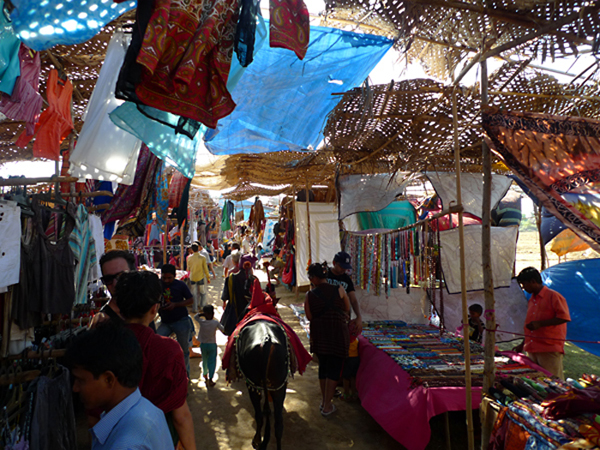
Jessica Davis, A Market in Goa, Digital photo, 2010, Reproduced with permission of the artist.
6. Reproducing the Imagined Exotic Space
Cultural collision in Arambol is nothing new. The West has historically influenced Goa since the sixteenth-century when the Portuguese first incorporated this area of India into their global trade route.
In 2009, India won the award for best international tourism campaign. Incredible !ndia, a national marketing campaign, was first launched in 2002 and generated a 16 percent tourism increase in the first year. In its second year, the campaign focused exclusively on ‘spiritual travel,’ such as yoga and ayurvedic massage—both of which are extremely popular in Goa. When Minister of Tourism Kumari Selija went to accept the award, she announced: ‘We never tire of telling the world that Indians treat their guests like gods. However, for those Europeans who don’t like reference to god I would like to repeat that guests are treated with great respect in India.’ [14]
The traditional idea of the fetish is a tendency to attribute god-like qualities and thus worship inanimate objects. Today, fetishism is widespread. Goa has a GDP almost three times higher than the rest of the country. [15] Do travelers find what they come for, or, are they so already indoctrinated with Namaste culture that they unknowingly overlook the frightening disparities between themselves and those living in the surrounding villages?
This slip between truth and representation has gone on long before the Goan full moon parties. Take for example the comparison in George Orwell’s Burmese Days.
The European Club, that remote, mysterious temple, that holy of holies far harder of entry than Nirvana! Po Kyin, the naked gutter-butter of Mandalay, the thieving clerk and obscure official, would enter that sacred place, call Europeans ‘old chap,’ drink whisky and soda and knock white balls to and fro on the green table! Ma Kin, the village woman, who had first seen the light through the chinks of a bamboo hut thatched with palm-leaves, would sit on a high chair with her feet imprisoned in silk stockings and high-heeled shoes (yes, she would actually wear shoes in that place!) talking to English ladies in Hindustani about baby-linen! [16]
The allure of the European Club for the locals lies in its very inaccessibility. Ma Kin can dress up like an English woman and discuss baby linen, but it is the underline inaccessibility of complete assimilation that keeps the British as the exotic other in her eyes. On the other side of the spectrum, since The Beatles first studied under Maharishi Mahesh, the Indian ashram has become a ‘remote, mysterious temple’ of the Western imagination. Like the European Club, the contemporary Indian Ashram has varying levels of cultural accessibility for the Western visitor.
While the two Western travelers back at Café Coffee Day appear absurdly out of place in Chennai they are ubiquitous in Arambol. Their ali baba pants and asymmetrical number of bangles would suggest they have obtained entrance into that remote and mysterious temple of cultural other, and yet, they most likely appeared to the Indian couples at the Café to be a cultural parody somewhat akin to Ma Kin.
Also noticeably out of place at Café Coffee Day that day was the enormous rucksacks, worn and bursting at the seams. Why would such nomads have such full packs? Despite the desire for ascetic experience, the affordability of exotic commodities like ali baba pants and ayurvedic creams is impossible to pass up.
7. Spencer Plaza: A Shoppers Dream Come True!
Shopping, both as leisure and as necessity, is tied to culture, economics, and politics. In Medieval Europe, the market and council chamber always occupied the same public space. The market, which was semi-open, was on the ground floor while the political administration was on the second floor. In this way, shopping was directly tied administration, government, and politics.
In the East, the traditional public market place is known as the bazaar, a site that generally took on an organic pattern of organization while keeping a high degree of self-expression amongst individual traders.
Market bazaars continue to flourish throughout India even today. Chennai has multiple. But the large scale, impressive market bazaars that became fixed in the Western imagination as characteristic of India and other parts of the East are increasingly replaced by a distinctively Western site of consumption—the mall.
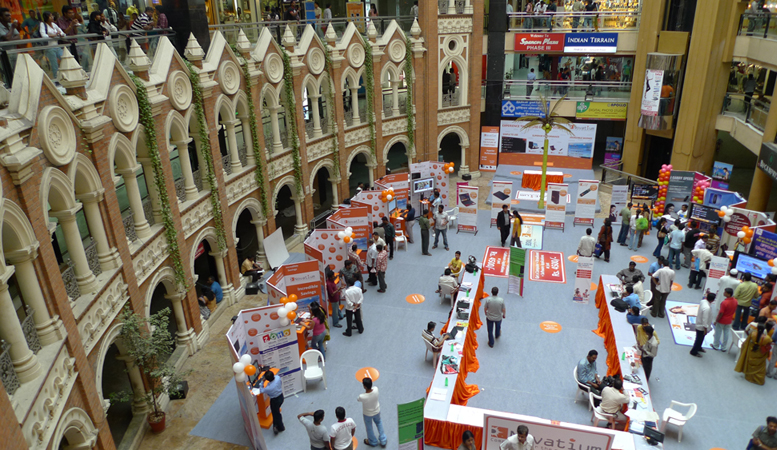
Jessica Awanohara, Spencer Plaza Interior, Digital photo, 2010, Reproduced with permission of the artist.
The rising number of Indian malls may be attributed to an increase in consumer spending, and availability of cheap credit, both of which are directly related to the late 90s economic liberalization of the country. Today, the retail industry in India contributes 10 percent of the GDP and 8 percent of total employment in India. [17]
Spencer Plaza, or, as the sign on the building states, ‘A Shoppers Dream Come True!’ is one of the oldest and largest malls in India. Located on Mound Road in Anna Salai the site (over 1 million square feet), has served as retail space since 1895—when it became the city’s first department store.
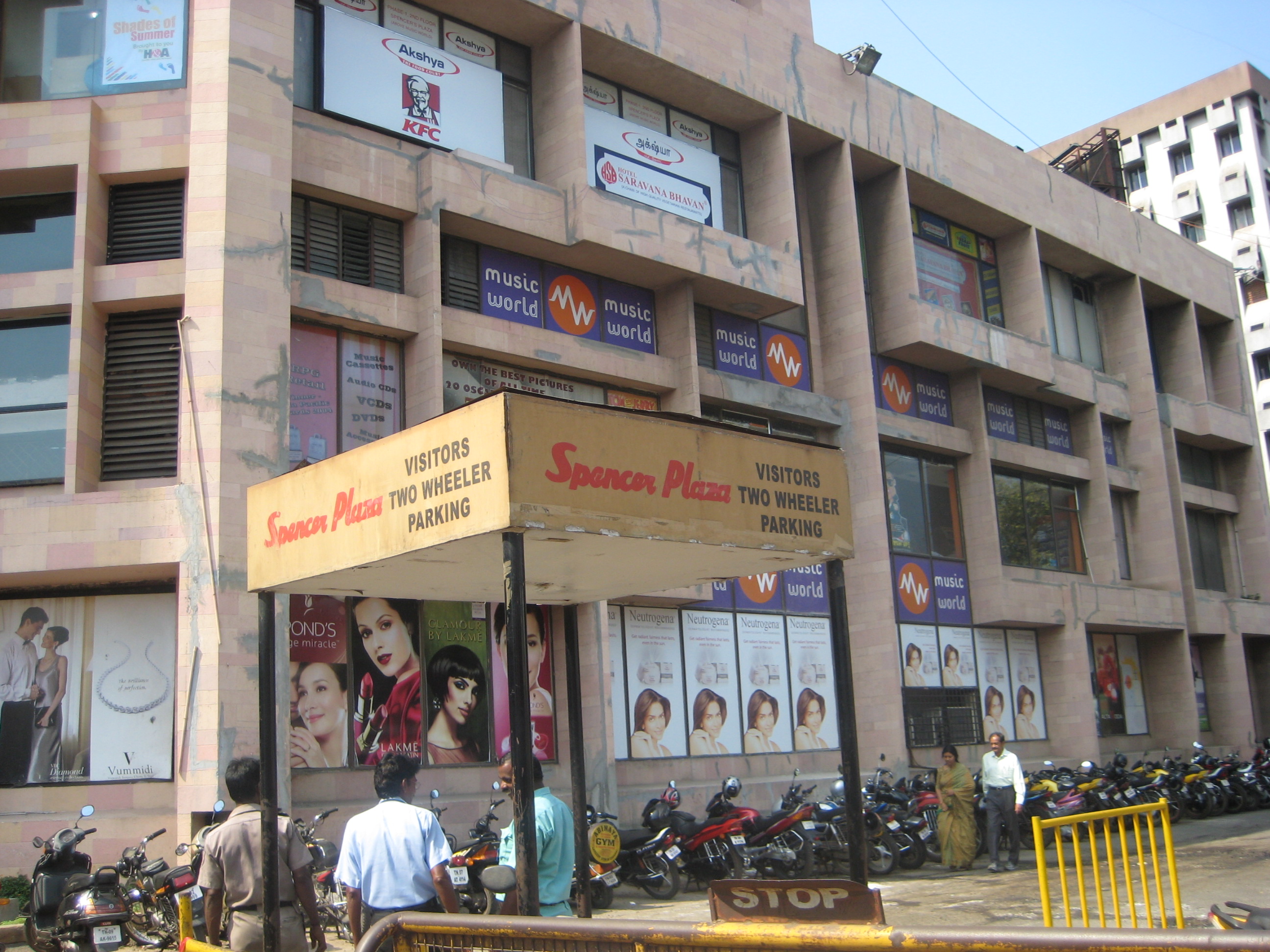
Morgan Campbell, Exterior of Spencer Plaza, Digital photo, 2010, Reproduced with permission of the artist.
Upon entering, the mall feels like a covered version of the chaotic streetscape. People pour through the doors en masse and walk around the awkwardly positioned metal detector and security guard who are in no way equipped to handle the some 15,000 visitors that come daily.
Unlike Western malls and some of the newer Indian malls appearing, Spencer Plaza maintains a hap-hazard, bazaar-like layout that is both seductive and overwhelming for the Western tourist who is used to sterile sheen and order of the mall. There is nothing glamorous about Spencer: the L on the Levis Store is crooked, the mannequin in his posh cricket wear in the window display of WestEnd looks as though he may tumble over at any moment. Spencer Plaza is a paradoxical presentation of contemporary possibilities and actualities, a place where hawkers stand outside their tiny, 8×10 foot shops, wait for tourists (which are rare) and avoid the hordes of teenage boys moving en masse toward the Pizza Hut at the food court.
‘The orient is an integral part of European material civilization and culture.’ [18] Identity is produced via a series of exchanges; nineteenth-century Orientalism was a cultural and political construct that had less to do with the actual geographical location of the Orient and more to do with the material goods that were exported from there. Characteristic of the early World’s Fairs was the use of material goods from the colonies that allowed the host country (i.e. England and France) to reconstruct the Eastern geographic location that would match the imagined version of these places.
Take for example the Egyptian exhibition featured during the 1889 World’s Fair in Paris. The exhibition was built to resemble a street in medieval Cairo. So careful was the construction, that one observer noted, ‘even the paint on the buildings was made dirty.’ [19] The fake streetscape was made to seem chaotic by bringing in fifty real Egyptian donkeys, which were complimented by Frenchmen dressed as Egyptians standing outside fake shops selling perfumes and pastries.’ [20]
Although both the World Fairs and Spencer Plaza are paradoxical presentations of imagined and real identities, the former masked this paradox while the later is explicit. Or is it? ‘The identity effect produced by any one centre’s spatial place in time is not only complex, highly nuanced and variable in detail,’ writes cultural theorist Meaghan Morris, ‘but also simple, massive and relatively enduring overall and over time, in space…shopping centres are overwhelmingly and constitutively paradoxical.’ [21]
Spencer Plaza stands as a unique dialectic between past and present; locals call the mall the ‘New within the Old,’ a nickname that echoes both historic and cultural difference. Travelers from the West understand the concept of the mall, however, the spatial arrangement of Spencer Plaza makes for a new shopping experience within an old concept (the mall). On the other hand, the chaotic spatial geography of Spencer is historically old for most locals; but many of the material goods, sandblasted micro minis, cappuccino machines, as well as the use of price tags is decidedly new.
8. Necessities and Relics
The contemporary shopping center is manufacturing a sense of place; in this case one that is explicitly for economic exchange. But economics alone do not adequately describe the social, cultural, and geographic ‘place,’ or the individual consumer’s rationale for going there. Shopping centers are fluid. Like people, they undergo transformations; they change their identity, be it their structural image or what they sell in the interior. And yet, there remains a ‘stirring tension between the massive stability of the structure, and the continually shifting, ceaseless spectacle within and around the ‘centre,’ [it] is one of the things that people who like shopping centres really love about shopping centres.’ [22]
The Landmark Department Store inside Spencer Plaza offers three-floors of primarily imported retail electronic goods. And yet the one item explicitly for export are the postcards depicting images of ‘real’ Indian people and real Indian places—places without department stores that sell the latest netbook models. These postcards uphold that image of India as a mythical and exotic place that can withstand global change, an image similar to the one produced by the Incredible !ndia campaign. These postcards reiterate India as a place of spiritual solitude, where the Minister of Tourism ensures that ‘foreigners are treated like gods,’ a statement that implies customer satisfaction to any international tourist.
The department store produced the first ‘commercial culture based on low markup, high volume’ [23] an economic technique that speed up the flow of goods and profits while creating a unique environment that was ‘the perfect organization of passions.’ [24] Perfect organization is also necessary to the commodification of cultural identity. Many nineteenth-century London and Parisian department stores had oriental departments. ‘Liberty’s in London specialized in Turkish embroidery, Indian silks and pyjamas, Persian bronzes, Japanese vases, Arab smoking rooms and so on.’ [25] The department store offered the unique opportunity to step off ‘the relatively public space of the street to enter another, more insistently commodified space,’ in this case, ‘it could also mean stepping to another culture.’ [26] The early Western department stores illustrated the way in which culture under colonialism became a fluid and even purchasable exchange. It was ‘not something that takes place (literally) ‘over there,’ it is also something that fashions out space within Western metropolitan centres.’ [27]
Much of what transpires at Spencer Plaza illustrates the same cultural slippage as occurred at Café Coffee Day. Identities of all kinds are determined by a series of exchanges. There are those who consciously produce and consume cultural identity and those who unconsciously produce and consume it. In this way culture is quite similar to a system of economics, which is a neither entirely natural nor unnatural system of exchange.
9. Conclusion
Culture, like capital, is reproducible. ‘Capital does, in the process of production, undergo an alteration of value. It reproduces the equivalent of its own value, and also produces an excess, a surplus value, which may itself vary, may be more or less according to the circumstances.’ [28] Marx was an economic theorist, not a cultural theorist—but he might have been. Culture, like identity, it is produced consciously and unconsciously. It is similar to the manufactured commodity, which may be endlessly replicated. But while the manufactured commodity retains the same form throughout a series of exchanges, culture changes every time it is exchanged. If culture is by its very essence self-replenishing, than culture as capital can never be completely managed.
Nevertheless, in many instances, culture becomes a tool of markets and ideologies of power. Orientalism was an ideology that masked the ‘enormously systematic discipline by which European culture was able to manage—and even produce—the Orient politically, sociologically militarily, ideologically, scientifically, and imaginatively during the post-enlightenment era.’ [29]
Franz Fanon’s was one of the first people to argue that the colonial imagination may not be reduced to or managed by simple binaries such as black/white/colonizer/colonized. While this is certainly true, contemporary globalism suggests that the historical tendency of capitalism to reduce things into categories of same and different, new and old persists. The World’s Fairs produced an Oriental cultural identity that may or may not have been authentic; but is the 21st century Goan cafe any different from capitalism’s 19th century project of cultivating exotic otherness?
The Orientalism marketed by Incredible !ndia is not destructive in the same sense as British imperialism, but it remains a big business that has its roots in the commodification and exploitation of geography and culture. Chennai has never been a great tourist destination, but at present, it doesn’t need to be. The city is quickly emerging as one of the largest IT/BPO centers in the world. Here, it is multinational corporations and their foreign CEOs who are being treated like gods.
The citizen is always becoming-a-subject and geographic space is always becoming an identifiably place. ‘People, in short, actively “construct locality”. They do so imaginatively, making use equally of trans-cultural symbolic resources.’ [30] Culture is marketable because it is by nature full of potential and possibility. Culture flourishes under the contemporary understanding of identity as fundamental and incomplete. ‘To be a person now entails the remorseless aspiration to self-knowledge, self-expression, and self-fulfillment.’ [31] If capitalism encourages greater self-identity through a process of creating working relationships with material goods than it is inevitable that culture becomes a tool of global capitalism. To argue an entirely negative outlook however is to ignore the force of culture as a fundamental a tool of expression, and thus one that will inevitably elude exploitation. Under power structures such as imperialism and globalism culture will be institutionalized, but culture, in its endless cycle of reproduction, is also the only force strong enough to shatter such monoliths.
[1] Café Coffee Day sign outside the shopping plaza.
[2] Nadeem, Shehzad. ‘Macaulay’s (Cyber) Children: The Cultural Politics of Outsourcing in India.’ Cultural Sociology, 3.1, (2009), 102-122.
[3] Said, Edward. Orientalism (London: Vintage, 1978).
[4] Lefebvre, Henri. The Urban Revolution, trans. R. Bononno (Minneapolis: University of Minnesota Press, 2007), 133.
[5] Bhabha, Homi K. The Location of Culture (New York: Routledge, 1994), 150.
[6] Ibid., 8.
[7] Benjamin, Walter. The Arcades Project, trans. H. E. McLaughlin (Cambridge, MA: The Belknap Press, 2003), 8.
[8] Finkielkraut, Alain. The Defeat of the Mind. trans. J. Friedlander (New York: Columbia University Press, 1996), 63.
[9] Ibid.
[10] Said, 1978, 21.
[11] Loomba, Ania. Colonialism/Postcolonialism. (New York: Routledge, 1998), 111.
[12] Spivak, Gayatri Chakravorty. A Critique of Postcolonial Reason: Toward A History of the Vanishing Present. (Cambridge: Harvard University Press, 1999), 359.
[13] 1965
[14] IANS. ‘Incredible India Campaign’s Success Raises Tourism Hopes,’ Deccan Herald, November 17 2009.
[15] Sawkar, Kalidas et al. ‘Tourism and the Environment: Issues of Concern in the Costal Zone of Goa‘ (Washington DC: The International Bank for Reconstruction and Development/The World Bank, 1998), 4.
[16] Orwell, George. Burmese Days. (New York: Mariner Books, 1974), 185.
[17] Hemalatha, K. G., Lakshmi Jagannathan, and K. Ravichandran. Shopping Behaviour in Malls in Globalised Economies. (Bangalore: IIMA Conference on Marketing Paradigms for Emerging Economies, 2009), 308.
[18] Said, 1978, 2.
[19] Mitchell, Timothy. ‘The world as exhibition’ Comparative Studies in Society and History 31.2 (1989), 217-236, 219.
[20] Ibid.
[21] Morris, Meaghan. ‘Things to do with shopping centres’ in (ed.) S. During, The Cultural Studies Reader (London: Routledge, 2004, 2nd edition), 393.
[22] Ibid., 394.
[23] Highmore, Ben. Cityscapes: Cultural Readings in the Material and Symbolic City (New York: Palgrave MacMillan, 2005), 58.
[24] Asendorf, Christoph. Batteries of Life: On the History of Things and Their Perception of Modernity, trans D. Reneau (Berkeley: University of California Press, 1993), 103.
[25] Highmore, 2005, 63.
[26] Ibid.
[27] Ibid.
[28] Marx, Karl. Capital. A New Abridgement (ed.), D. McLellan (New York: Oxford University Press, 1995) xviii.
[29] Said, 1979, 3.
[30] Donald, James. Imagining the Modern City (Minneapolis: University of Minnesota Press, 1999), 181.
[31] Ibid.
Morgan Campbell is a is a PhD student of of Urban Planning and Public Policy at Rutgers University. Her research looks at physical landscapes that are sites of cross-cultural exchange and the impact these exchanges have on local residents, particularly young women and men.http://utopiography.com/